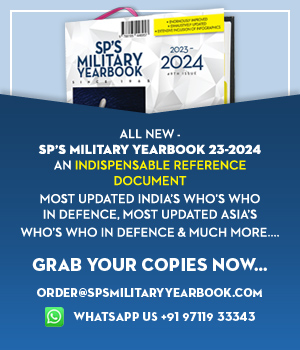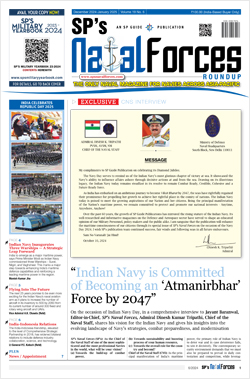INDIAN ARMED FORCES CHIEFS ON OUR RELENTLESS AND FOCUSED PUBLISHING EFFORTS
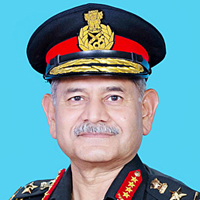
The insightful articles, inspiring narrations and analytical perspectives presented by the Editorial Team, establish an alluring connect with the reader. My compliments and best wishes to SP Guide Publications.

"Over the past 60 years, the growth of SP Guide Publications has mirrored the rising stature of Indian Navy. Its well-researched and informative magazines on Defence and Aerospace sector have served to shape an educated opinion of our military personnel, policy makers and the public alike. I wish SP's Publication team continued success, fair winds and following seas in all future endeavour!"

Since, its inception in 1964, SP Guide Publications has consistently demonstrated commitment to high-quality journalism in the aerospace and defence sectors, earning a well-deserved reputation as Asia's largest media house in this domain. I wish SP Guide Publications continued success in its pursuit of excellence.
- MoD initiates comprehensive review of Defence Acquisition Procedure 2020, pushes for defence reforms
- G7: The Swansong
- Kalinga Connect: South Asia to Polynesia
- Advanced MRSAM for India for a greater firepower
- Must Credit DRDO for Operation Sindoor, now what is next for defence R&D?
- Operation Sindoor | Day 2 DGMOs Briefing
- Operation Sindoor: Resolute yet Restrained
Charting India's Naval Power
On the occasion of Indian Navy Day, in a comprehensive interview to SP's Naval Forces, Admiral R. Hari Kumar, Chief of the Naval Staff, gave his insights into the evolving landscape of Navy's strategies, combat preparedness, modernisation, and HR initiatives
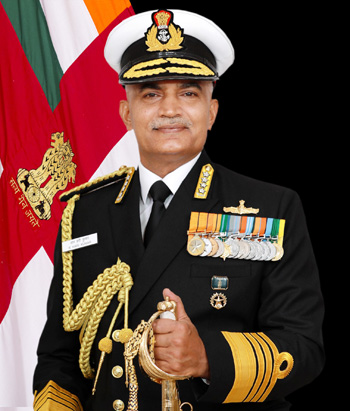
SP's Naval Forces (SP's): Navy has been pushing the case for IAC-2 since many years. Recent reports suggest that the case is being pushed yet again. Why the IAC-2 is a necessity for India and what all capabilities will it bring to our Navy and what all opportunities will this create for the Indian industry?
Admiral R. Hari Kumar, Chief of the Naval Staff (CNS): We, as a nation, have to shape our growth trajectory in tandem with our aspirations, roles and responsibilities. Having a robust National Security Policy and being militarily ready to address all threats and challenges is key to fulfilling this objective. Naval Acquisitions through indigenous shipbuilding provide a great opportunity to rekindle the national economy and be a key driver towards 'AtmaNirbhar Bharat', effectively ploughing back defence budget into the economy. The 'plough back' effect of indigenous construction of INS Vikrant, will be experienced on an even larger scale with the acquisition of a third carrier, with larger indigenous content and involvement of MSMEs/ ancillary industries.
"Having a robust National Security Policy and being militarily ready to address all threats and challenges is key to fulfilling this objective"
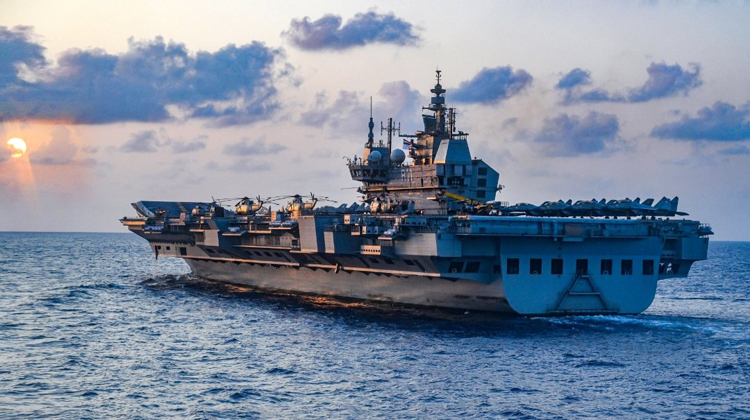
The Navy envisaged its future Indigenous Aircraft Carrier - 2 to be a 65,000 tonnes Carrier capable of maximum speed of 30 knots and employ Catapult Assisted Take-off but Arrested Recovery (CATOBAR) concept of flying operations. The carrier would be designed and built in India. India's growing dependence on the seas for national prosperity and growth requires commensurate capability to protect our SLOCs and maritime interests. In accordance with the MCPP 2022 - 37, it is envisaged that Indian Navy(IN) would need to undertake concurrent sea control operations by Carrier Task Forces (CTF) in geographically separate locations. Therefore, a three-carrier force would be essential to provide Sea Control Operations in the region. Considering the indigenous expertise available for designing and construction of IAC-1 (INS Vikrant), as well as the development of many new, wide technologies, a repeat order of IAC-1 with suitable modifications to incorporate lessons learnt from IAC-1 and future capabilities envisaged is being pursued at this stage. The case is under consideration at MoD.
SP's: Can you throw the light on the P-75(I) programme status and its future?
CNS: The case is being progressed as per the guidelines of the Strategic Partnership Model of the Defence Procurement Procedure. Field Evaluation Trials will be bids and this would be followed by commercial negotiations and contract conclusion.
"A three-carrier force would be essential to provide Sea Control Operations in the region"
SP's: China's combat preparedness – Kindly give us some inputs on our Navy's combat preparedness versus PLAN.
CNS: The PLAN has been expanding at an unprecedented pace and is expected to have a surface fleet of about 400 by 2025. While we may not be able to match the numbers, we are constantly fine-tuning our concept of operations and acquisition plans to effectively counter the threats that could be imposed by such a fleet. The Bharatiya Nausena is seized of the security implications of the enhanced Chinese presence in the Indian Ocean Region and maintains a constant and close watch on such developments. The actions of the IN may be summarised as follows:-
- The IN maintains credible Maritime Domain Awareness (MDA) as well as an appropriate degree of readiness to meet any emergent situations.
- IN ships and aircraft are regularly deployed to maintain continuous and effective surveillance to monitor extra-regional/ non-littoral ships and submarines in our area of operations/ interest.
- Further, electronic surveillance of the maritime zones is undertaken using a chain of coastal/ offshore radars, the National Automatic Identification System (AIS) chain and the Long Range Identification and Tracking (LRIT) System.
SP's: How do you perceive the overall strength of our Navy's fleet? Are you satisfied with the pace of modernisation and the inductions in view of the threat perceptions from East and West of our country?
CNS: The Bharatiya Nausena is steadfastly striving for rapid modernisation of the Force through indigenous route.The Navy is evolving continuously to meet emerging challenges to our maritime interests. The modernisation programme of IN is centred on AtmaNirbharta which defines India's growth story. Threats, missions, capability development and affordability have, remained dominant factors in the force structure planning of the Service. The expansion plan in future includes the induction of aircraft carriers, state-of-the-art Next Generation Warships and submarines, Carrier-based fighters and helicopters as well as augmentation of unmanned solutions to enhance combat capabilities, and induction of niche technology and equipment to address emergent and future threats.
"The Bharatiya Nausena (IN) is steadfastly striving for rapid modernisation of the Force through indigenous route"
Towards expeditious capacity and capability building of the Navy, 65 out of 67 ships/ submarines under construction are being built in Indian shipyards. Further, Acceptance of Necessity (AoN) also exists for the construction of 24 ships and submarines all to be constructed at Indian shipyards. While all these platforms will have a high indigenous content, they will be equipped with 'State of The Art' systems and advanced weapons and sensors with high lethality. While the Bharatiya Nausena evolves towards becoming a fully AtmaNirbhar Force, the Combat Capability of the platforms are given the highest priority. In addition, the Navy is already progressing well towards enhancing its surveillance capability through the induction of Long Range Maritime Aircraft, Remotely Operated/ Autonomous Surface, Underwater and Aerial vehicles, with adequate impetus to emerging niche technology such as AI and Robotics to enhance IN's combat and surveillance capability.
SP's: Would you kindly like to comment as to how the Navy plans to absorb AI in its overall scheme of operations? It is being debated that AI will bring substantial number of advantages, however, it may also have some undesired disadvantages. Your views on this, please?
CNS: The aspects of artificial intelligence, machine learning and big-data analysis, coupled with extant capabilities for wide-area surveillance and networking would result into a transparent battle space with faster decision-making and enable fast-paced operations through Information Dominance.
"AI enables independent decision-making during the progress of operations with minimal manual intervention"
'Hybrid Fleets' of crewed and un-crewed systems with AI, delivering greater capability at significantly lower operating cost, will be norm of the day. Un-crewed systems operating in all domains as a rapidly adaptable with AI and interconnected network will provide access to areas denied to crewed platforms, provide better situational awareness, greater range & persistence.
AI enables independent decision-making during the progress of operations with minimal manual intervention. However, the human element can be completely taken out from this loop. AI is not only a function of technological developments but also the appetite of the users who employ them. Accordingly, the levels of AI will largely depend on envisaged Concept of Operations (CONOPs), the environment in which our platforms operate, technological advancements and the level of autonomy that the users are comfortable to allow to these systems.
Bharatiya Nausena is progressively developing and implementing a framework for Data Unification and Management saw best industry practices and has already established Centers of Excellence in 'AI' and Big Data Analytics. Towards nurturing the AI penetration, Indian Navy Incubation Centre for Artificial Intelligence (INICAI) has been established by IN in January 2023 at Bengaluru to fast track development of AI use cases in close liaison with Indian Industries. The IN has identified a total of 38 AI Use Cases for implementation. These include ops use cases for maritime operation viz., detection, identification, classification, collision avoidance, force protection measure etc and for training through language translators to aid in training of Indian and foreign trainees. These use cases are envisaged for implementation onboard shortly.
"As part of 'SHIPS FIRST' outlook, we are relentlessly pursuing to make our personnel happy by providing them with the best of the amenities and infrastructure to improve the quality of life"
To maintain these critical initiatives, an AI core group has also been established by IN. The core group monitors the progress of AI in the IN and reviews all AI projects being undertaken by various stakeholders.
SP's: Request for updates on the latest initiatives towards boosting the morale of the human resource of our Navy as this remains the most important asset of any of the forces in the world.
CNS: As part of 'SHIPS FIRST' outlook, we are relentlessly pursuing to make our personnel happy by providing them with best of the amenities and infrastructure to improve the quality of life. In order to achieve our objectives towards boosting the morale of the personnel, various initiatives undertaken by IN are enumerated in succeeding paragraphs.
- Key on Arrival. As a progressive HR measure, the officers and sailors reporting on transfer are being provided accommodation through Key on Arrival initiative.
- Digital HR Processes. Adoption of digital HR processes is a key focus area towards enhancing transparency and 'ease of businesses'. Some of the major digitisation initiatives are as follows:-
- Electronic-CRs, e-Service Documents, SPARROW (Smart Performance Appraisal Report Recording Online Window) (for defence civilians), and a revamped HR website that facilitates online work flows for NOCs for passports, civil employment, change of address, joining report etc.
- Indian Naval Entrance Test (INET) for Agniveer recruitment.
- SWASTH Telemedicine.
- e-Sehat.
- SAMUHA Community website.
- SPARSH for pensioners.
- Digitisation of personal records.
- Online delivery by Indian Naval Canteen Service.
- Implementation of 360 Degree Appraisal System. In addition to existing confidential reports by superiors, feedback from peers/ colleagues and subordinates has been implemented as an additional input for promotion to higher ranks.
Nari Shakti – Overall approach is that of 'All roles, all ranks'
Enhanced Avenues for Women.
- Women Officers Onboard Ships. Women officers have been appointed onboard warships commencing December 2020. Appointment of women officers' onboard warships was last undertaken from 1997 to 1999. However, it could not be implemented as a policy, due to limited availability of accommodation and facilities to cater to privacy needs of women officers. Further, in order to ensure zero discrimination, adequate platforms were required for routing all women officers, from sea going branches, for appointment onboard ships to enable their promotion to higher ranks. Therefore, at that stage, deploying women officers to sea could not be continued. In the last two decades, newer ships have been inducted into the Navy that cater for privacy needs of women officers. Therefore, commencing end 2020, women officers have been appointed onboard warships. Currently 33 women officers are appointed to ships and these numbers are being progressively augmented.
- Women Officer Induction.
- IN has commenced induction of women into all branches with effect from (w.e.f.) June 2023 batch.
- With regards to NDA, entry of women cadets was commenced w.e.f. June 2022 batch and three vacancies were allocated to IN. Commencing January 2024 batch, the number of vacancies for women cadets at NDA have been increased from three to 12.
- At Indian Naval Academy (INA), women cadets are now eligible to join through '10+2 B Tech' entry scheme. Applications for same have been received and their training would commence w.e.f. January 2024.
- Also, women induction through 'UPSC/ NDA Entry' into INA would commence w.e.f. June 2024 batch.
- Permanent Commission to Women Officers. SSC women officers in the Bharatiya Nausena are eligible for consideration for grant of Permanent Commission. As on date 72 women officers (excluding Medical and Dental officers) have been granted PC.
- Women Agniveers. The first batch of Agniveers comprising 272 women candidates have completed their basic training at INS Chilka. Further, the interest of women candidates towards joining Bharatiya Nausena as Agniveer has been growing and a total of 462 women have been recruited in the second batch, who are presently undergoing training at INS Chilka. With the third batch inducted, Women Agniveer numbers have crossed 1,100.
- Naval Air Operations (NAO) Officers on Helicopters. Until 2019, women officers were being commissioned as Pilots and NAOO only for shore-based aircraft. However, in order to employ women at par with male officers, women officers have also been streamed as specialist NAOO into helicopters commencing 2020, wherein they will operate from shipborne flights.
- RPA Stream. Women officers can join the Remotely Piloted Aircraft (RPA) stream and the first woman officer joined RPA squadron in March 2021.
- Overseas Assignments. Woman NAO officers are being deputed overseas since September 2020, as part of Dornier aircrew. Though the aircrew is being rotated after one year, at least one women officer has continued to figure in the selection merit. In addition, women officers are also deputed abroad for shorter durations as part of Mobile Training Teams and other foreign cooperation engagements.

Agnipath Scheme
The Agnipath Scheme was launched by the Government of India on June 14, 2022. The scheme is aimed at transforming the Armed Forces into a much more youthful and technically adept warfighting force by ensuring a fine balance between youthful and experienced personnel in its ranks. Both men and women are being enrolled under this scheme and they are known as 'Agniveers'. In order to facilitate the enhancement of the education qualification of 'Agniveers', IN has initiated an Outreach Programme. Under the programme, IN has signed MoUs for award of Class XII certificates/ Degree/ Diploma (for SSR sailors). Following MoUs have been concluded with Ministry of Education and Ministry of Skill Development Entrepreneurship in this regard:-
- MoU with National Institute of Open Schooling (NIOS), for award of 12th pass certificate to 10th pass Agniveers.
- MoU with IGNOU, to facilitate award of Bachelor's Degree to 12th pass Agniveers.
- MoU with Directorate General of Training (DGT), under the Flexi-MoU scheme of DGT, tofacilitate award of National Trade Certificate (NTC) to Agniveers.
- Agreement with National Council for Vocational Education and Training (NCVET), for award of 'Awarding Body (Dual Category)' recognition to Services. HQ Southern Naval Command (SNC) is the AB (Dual) on behalf of IN. AB status would not only enable HQ SNC/ Training Schools to create suitable Qualifications or 'Kaushal Praman Patra' for Agniveers, but would also empower them to align regular sailors' courses to the National Skill Qualification Framework (NSQF) of NCVET.
Community Living
Naval Wellness and Welfare Association (NWWA). NWWA has been made more relevant to contemporary times including the change to gender neutral nomenclature. Some of the notable achievements of NWWA has been:-
- Conduct of G20 THINQ 2023, both at national and international level.
- MoU with engineering colleges.
- Early-intervention centres at naval commands.
- SSB mentoring programme for naval wards.




